Mineralogy and Major Element Geochemistry of the Oligocene Barail Group Sandstones from the Sylhet Trough, Bengal Basin: Provenance and Tectonic Implications
Abstract
:1. Introduction
2. General Geology
3. Materials and Methods
4. Results
4.1. Framework Mineral Composition
4.2. Heavy Mineral Composition
4.3. Major Element Geochemistry
4.4. Sandstone Classification and Maturity
5. Discussion
5.1. Bulk Chemical Compositon
5.2. Provenance
5.3. Weathering and Paleoclimate
5.4. Tectonic Implications
6. Conclusions
- The Oligocene Barail sandstones mainly comprise monocrystalline quartz with low feldspar and lithic fragments, classifying them as sublitharenite to subarkose types.
- The results suggest that the Barail Group sediments originated from felsic igneous, low-grade metamorphic, and recycled sources like the Indian craton and proto-Himalayan regions.
- Mineralogical and geochemical shreds of evidence show moderate to strong chemical weathering, implying a sub-humid to humid climate and low relief in the source area during the Oligocene.
- The tectonic discrimination diagrams and detrital compositions suggest that during the Oligocene, the Bengal Basin setting transitioned from a passive to an active margin setting, pointing to the proto-Himalayan uplift due to the initial collision between the Indian and the Eurasian plates.
Author Contributions
Funding
Data Availability Statement
Acknowledgments
Conflicts of Interest
References
- Abdullah, R.; Aurthy, M.R.; Khanam, F.; Hossain, M.M.; Sayem, A.S.M. Structural development and tectonostratigraphic evolution of the Sylhet Trough (northeastern Bengal Basin) in the context of Cenozoic Himalayan Orogeny: Insights from geophysical data interpretation. Mar. Pet. Geol. 2022, 138, 105544. [Google Scholar] [CrossRef]
- Bas, M.L.; Maitre, R.L.; Streckeisen, A.; Zanettin, B.; IUGS Subcommission on the Systematics of Igneous Rocks. A chemical classification of volcanic rocks based on the total alkali-silica diagram. J. Petrol. 1986, 27, 745–750. [Google Scholar] [CrossRef]
- Nesbitt, H.W.; Young, G.M. Prediction of some weathering trends of plutonic and volcanic rocks based on thermodynamic and kinetic considerations. Geochim. Cosmochim. Acta 1984, 48, 1523–1534. [Google Scholar] [CrossRef]
- Dickinson, W.R. Interpreting Provenance Relations from Detrital Modes of Sandstones. In Provenance of Arenites; Zuffa, G.G., Ed.; Springer: Dordrecht, The Netherlands, 1985; pp. 333–361. ISBN 978-90-481-8413-2. [Google Scholar]
- Suttner, L.J.; Dutta, P.K. Alluvial sandstone composition and paleoclimate; I, Framework mineralogy. J. Sediment. Res. 1986, 56, 329–345. [Google Scholar]
- Roser, B.P.; Korsch, R.J. Determination of Tectonic Setting of Sandstone-Mudstone Suites Using SiO2 Content and K2O/Na2O Ratio. J. Geol. 1986, 94, 635–650. [Google Scholar] [CrossRef]
- Fedo, C.M.; Wayne Nesbitt, H.; Young, G.M. Unraveling the effects of potassium metasomatism in sedimentary rocks and paleosols, with implications for paleoweathering conditions and provenance. Geology 1995, 23, 921–924. [Google Scholar] [CrossRef]
- Garzanti, E.; Andò, S. Heavy mineral concentration in modern sands: Implications for provenance interpretation. Dev. Sedimentol. 2007, 58, 517–545. [Google Scholar]
- He, Z.; Guo, Z.; Yang, F.; Sayem, A.S.M.; Wu, H.; Zhang, C.; Hao, Q.; Xiao, G.; Han, L.; Fu, Y.; et al. Provenance of Cenozoic Sediments in the Xining Basin Revealed by Nd and Pb Isotopic Evidence: Implications for Tectonic Uplift of the NE Tibetan Plateau. Geochem. Geophys. Geosystems 2019, 20, 4531–4544. [Google Scholar] [CrossRef]
- Yeasmin, R.; Abdullah, R.; Hossain, M.S.; Ao, S.; Khan, M.S.H.; Sayem, A.S.M.; Xiao, W.; Zhang, P.; Zoarder, A.; Tithi, T.J. Petrography, geochemistry and detrital zircon U–Pb dating of the Pliocene-Pleistocene Dupi Tila Formation from the Lalmai Anticline, Bengal Basin: Regional tectonic implications. Geol. J. 2024, 59, 1239–1261. [Google Scholar] [CrossRef]
- Sayem, A.S.M.; Mondal, P.; Alam, M.S.; Abdullah, R.; Rahman, J.J.; Yeasmin, R. Provenance signature and tectonic setting of the Pliocene Tipam Sandstone Formation from the Chittagong Tripura Fold Belt of the Bengal Basin. J. Sediment. Environ. 2024. [Google Scholar] [CrossRef]
- Uddin, A.; Lundberg, N. Unroofing history of the eastern Himalaya and the Indo-Burman ranges; heavy-mineral study of Cenozoic sediments from the Bengal Basin, Bangladesh. J. Sediment. Res. 1998, 68, 465–472. [Google Scholar] [CrossRef]
- Uddin, A.; Lundberg, N. Cenozoic history of the Himalayan-Bengal system: Sand composition in the Bengal basin, Bangladesh. Geol. Soc. Am. Bull. 1998, 110, 497–511. [Google Scholar] [CrossRef]
- Bhatia, M.R. Plate Tectonics and Geochemical Composition of Sandstones. J. Geol. 1983, 91, 611–627. [Google Scholar] [CrossRef]
- Murphy, J.B. Tectonic influence on sedimentation along the southern flank of the late Paleozoic Magdalen basin in the Canadian Appalachians: Geochemical and isotopic constraints on the Horton Group in the St. Marys basin, Nova Scotia. Geol. Soc. Am. Bull. 2000, 112, 997–1011. [Google Scholar] [CrossRef]
- Verma, S.P.; Armstrong-Altrin, J.S. New multi-dimensional diagrams for tectonic discrimination of siliciclastic sediments and their application to Precambrian basins. Chem. Geol. 2013, 355, 117–133. [Google Scholar] [CrossRef]
- Sayem, A.S.M.; Rokonuzzaman, M.; Shahriar, M.S.; Abdullah, R.; Bari, Z.; Hossen, M.S. Major and trace element geochemistry of the Atrai River sediments from the Bengal Basin (Bangladesh): Implication for provenance, chemical weathering, and tectonic setting in the southeastern Himalaya. Arab. J. Geosci. 2023, 16, 487. [Google Scholar] [CrossRef]
- Khanam, F.; Rahman, M.J.J.; Alam, M.M.; Abdullah, R. Sedimentology and basin-fill history of the Cenozoic succession of the Sylhet Trough, Bengal Basin, Bangladesh. Int. J. Earth Sci. 2021, 110, 193–212. [Google Scholar] [CrossRef]
- Hossain, M.; Khan, M.; Abdullah, R.; Mukherjee, S. Late Cenozoic transpression at the plate boundary: Kinematics of the eastern segment of the Dauki Fault Zone (Bangladesh) and tectonic evolution of the petroliferous NE Bengal Basin. Mar. Pet. Geol. 2021, 131, 105133. [Google Scholar] [CrossRef]
- Hossain, H.M.Z.; Roser, B.P.; Kimura, J.-I. Petrography and whole-rock geochemistry of the Tertiary Sylhet succession, northeastern Bengal Basin, Bangladesh: Provenance and source area weathering. Sediment. Geol. 2010, 228, 171–183. [Google Scholar] [CrossRef]
- Najman, Y.; Bickle, M.; BouDagher-Fadel, M.; Carter, A.; Garzanti, E.; Paul, M.; Wijbrans, J.; Willett, E.; Oliver, G.; Parrish, R. The Paleogene record of Himalayan erosion: Bengal Basin, Bangladesh. Earth Planet. Sci. Lett. 2008, 273, 1–14. [Google Scholar] [CrossRef]
- Najman, Y. The detrital record of orogenesis: A review of approaches and techniques used in the Himalayan sedimentary basins. Earth-Sci. Rev. 2005, 74, 1–72. [Google Scholar] [CrossRef]
- Garzanti, E.; Baud, A.; Mascle, G. Sedimentary record of the northward flight of India and its collision with Eurasia (Ladakh Himalaya, India). Geodin. Acta 1987, 1, 297–312. [Google Scholar] [CrossRef]
- Najman, Y.; Allen, R.; Willett, E.A.F.; Carter, A.; Barfod, D.; Garzanti, E.; Wijbrans, J.; Bickle, M.J.; Vezzoli, G.; Ando, S.; et al. The record of Himalayan erosion preserved in the sedimentary rocks of the Hatia Trough of the Bengal Basin and the Chittagong Hill Tracts, Bangladesh. Basin Res. 2012, 24, 499–519. [Google Scholar] [CrossRef]
- Rahman, M.J.J.; Sayem, A.S.M.; Bhuiyan, M.H. Geochemistry of the Plio-Pleistocene Dupi Tila sandstones from the Surma Basin, Bangladesh: Implications for provenance, tectonic setting and weathering. Himal. Geol. 2014, 35, 162–170. [Google Scholar]
- Rahman, M.J.J.; Xiao, W.; Hossain, M.S.; Yeasmin, R.; Sayem, A.S.M.; Ao, S.; Yang, L.; Abdullah, R.; Dina, N.T. Geochemistry and detrital zircon U–Pb dating of Pliocene-Pleistocene sandstones of the Chittagong Tripura Fold Belt (Bangladesh): Implications for provenance. Gondwana Res. 2020, 78, 278–290. [Google Scholar] [CrossRef]
- Dina, N.T.; Rahman, M.J.J.; Hossain, M.S.; Sayem, A.S.M. Provenance of the Neogene succession in the Bandarban structure, South-East Bengal Basin, Bangladesh: Insights from petrography and petrofacies. Himal. Geol. 2016, 37, 141–152. [Google Scholar]
- Rahman, M.J.J.; Sayem, A.S.M.; McCann, T. Geochemistry and provenance of the Miocene sandstones of the Surma group from the Sitapahar anticline, Southeastern Bengal Basin, Bangladesh. J. Geol. Soc. India 2014, 83, 447–456. [Google Scholar] [CrossRef]
- Alam, M.; Alam, M.M.; Curray, J.R.; Chowdhury, M.L.R.; Gani, M.R. An overview of the sedimentary geology of the Bengal Basin in relation to the regional tectonic framework and basin-fill history. Sediment. Geol. 2003, 155, 179–208. [Google Scholar] [CrossRef]
- Shamsuddin, A.H.M. Geologic evolution of the Bengal Basin and its implication in hydrocarbon exploration in Bangladesh. Indian J. Geol. 1997, 69, 93. [Google Scholar]
- Reimann, K.-U. Geology of Bangladesh; Gebrüder Borntraeger Verlag: Berlin, Germany, 1993. [Google Scholar]
- Abdullah, R.; Sayem, A.S.M.; Yeasmin, R.; Rahman, M.M.; Bari, Z.; Khanam, F. Plio-Pleistocene to Recent tectonostratigraphic evolution of the Lalmai anticline in the western Indo-Burman Range (Bangladesh): Insights from lithofacies analysis and structural synthesis. Arab. J. Geosci. 2021, 14, 392. [Google Scholar] [CrossRef]
- Evans, P. Tertiary succession in Assam. Trans. Min. Geol. Inst. India 1932, 27, 155–260. [Google Scholar]
- Mange, M.A.; Maurer, H.F.W. Heavy Minerals in Colours; Springer: Dordrecht, The Netherlands, 1992; ISBN 978-94-010-5019-7. [Google Scholar]
- Goto, A. Quantitative analysis of rock samples by an X-ray fluorescence spectrometer (I). Rigaku J. 1994, 11, 40–59. [Google Scholar]
- Goto, A. Quantitative analysis of rock samples by an X-ray fluorescence spectrometer (II). Rigaku J. 1996, 13, 20–38. [Google Scholar]
- Taylor, S.R.; McLennan, S.M. The Continental Crust: Its Composition and Evolution; Blackwell: Oxford, UK, 1985. [Google Scholar]
- Herron, M.M. Geochemical classification of terrigenous sands and shales from core or log data. J. Sediment. Res. 1988, 58, 820–829. [Google Scholar]
- Folk, R.L. Petrology of sedimentary rocks; Hemphill Publishing Company: Austin, TX, USA, 1980. [Google Scholar]
- Potter, P.E. Petrology and Chemistry of Modern Big River Sands. J. Geol. 1978, 86, 423–449. [Google Scholar] [CrossRef]
- Pettijohn, F.J.; Potter, P.E.; Siever, R. Sand and sandstone. Plate motions inferred from major element chemistry of lutites. Precambrian Res. 1972, 147, 124–147. [Google Scholar]
- Hossain, H.M.Z. Major, trace, and REE geochemistry of the Meghna River sediments, Bangladesh: Constraints on weathering and provenance. Geol. J. 2020, 55, 3321–3343. [Google Scholar] [CrossRef]
- Bracciali, L.; Najman, Y.; Parrish, R.R.; Akhter, S.H.; Millar, I. The Brahmaputra tale of tectonics and erosion: Early Miocene river capture in the Eastern Himalaya. Earth Planet. Sci. Lett. 2015, 415, 25–37. [Google Scholar] [CrossRef]
- Hayashi, K.-I.; Fujisawa, H.; Holland, H.D.; Ohmoto, H. Geochemistry of 1.9 Ga sedimentary rocks from northeastern Labrador, Canada. Geochim. Cosmochim. Acta 1997, 61, 4115–4137. [Google Scholar] [CrossRef] [PubMed]
- Roser, B.P.; Korsch, R.J. Provenance signatures of sandstone-mudstone suites determined using discriminant function analysis of major-element data. Chem. Geol. 1988, 67, 119–139. [Google Scholar] [CrossRef]
- Nesbitt, H.W.; Young, G.M. Early Proterozoic climates and plate motions inferred from major element chemistry of lutites. Nature 1982, 299, 715–717. [Google Scholar] [CrossRef]
- Harnois, L. The CIW index: A new chemical index of weathering. Sediment. Geol. 1988, 55, 319–322. [Google Scholar] [CrossRef]
- Weltje, G.J.; Meijer, X.D.; De Boer, P.L. Stratigraphic inversion of siliciclastic basin fills: A note on the distinction between supply signals resulting from tectonic and climatic forcing. Basin Res. 1998, 10, 129–153. [Google Scholar] [CrossRef]
- Ingersoll, R.V.; Suczek, C.A. Petrology and Provenance of Neogene Sand from Nicobar and Bengal Fans, DSDP Sites 211 and 218. SEPM J. Sediment. Res. 1979, 49, 1217–1228. [Google Scholar] [CrossRef]

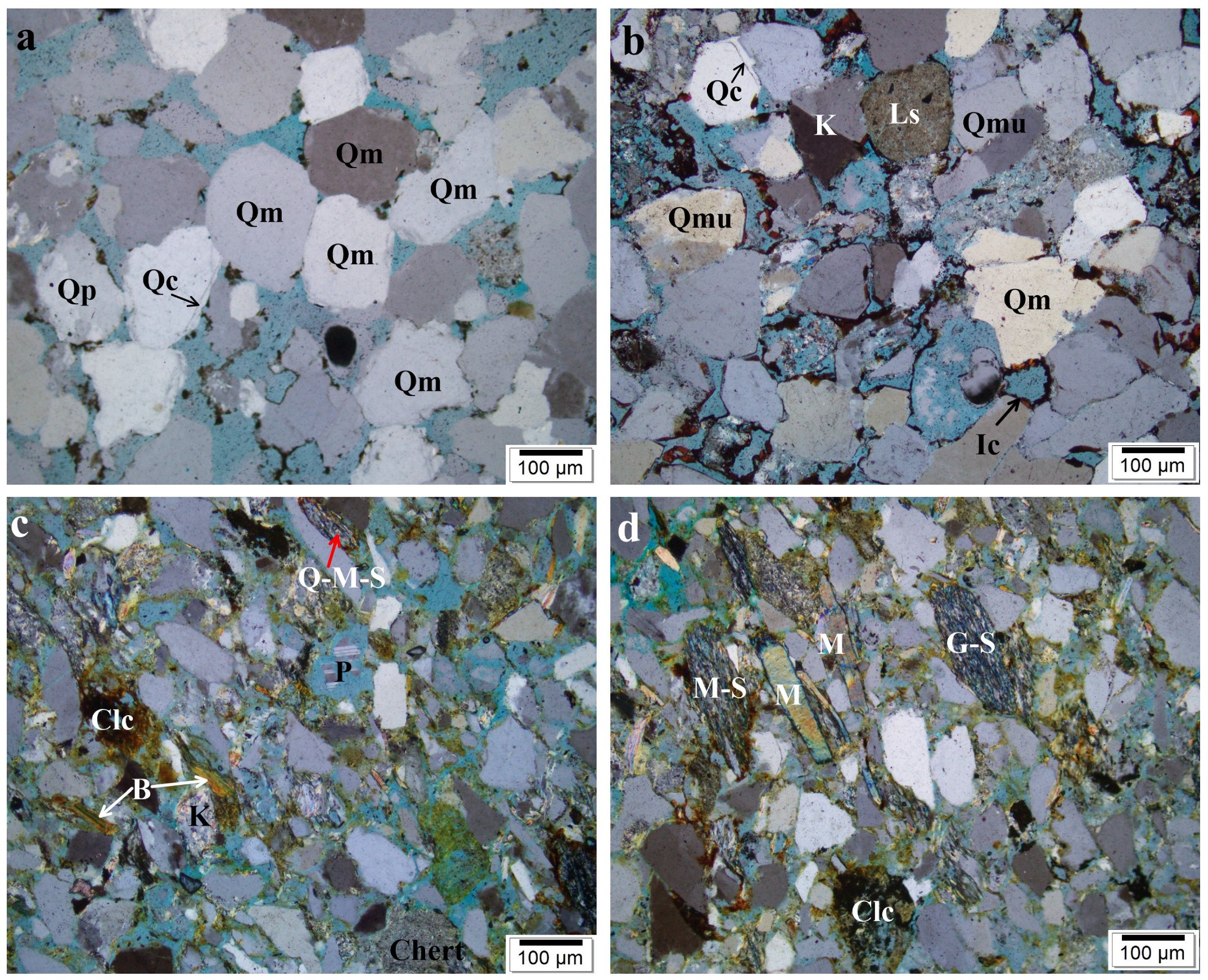
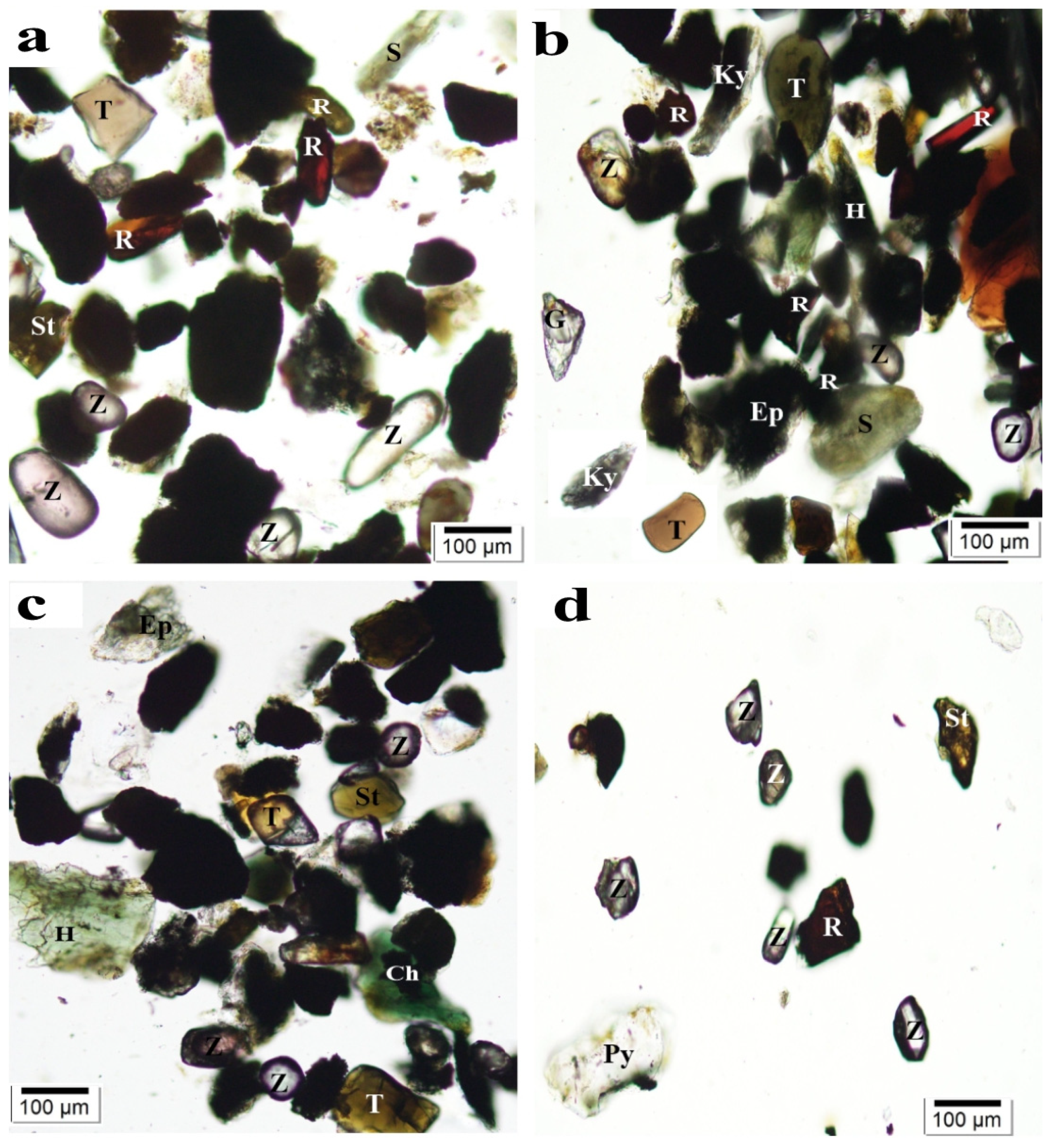
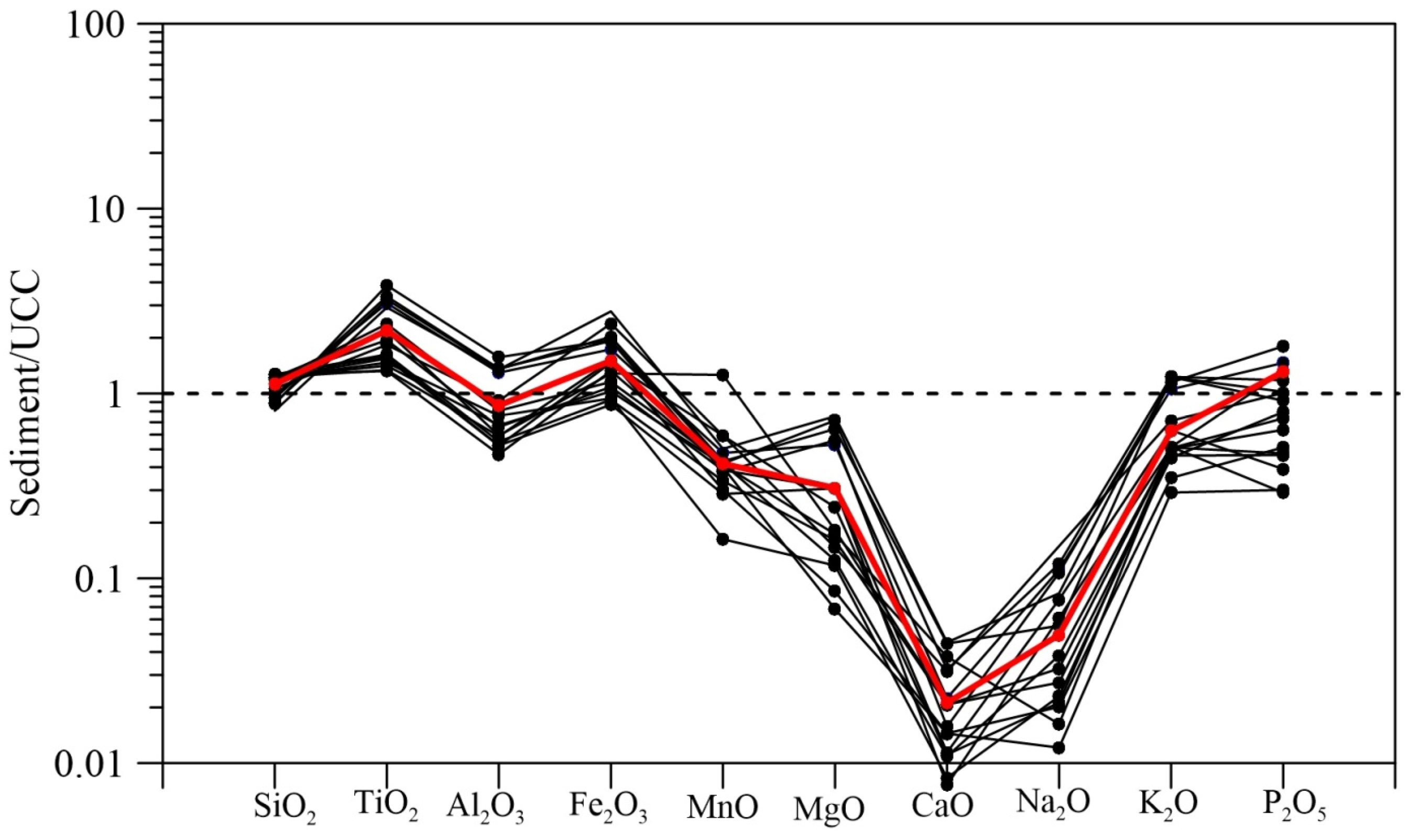



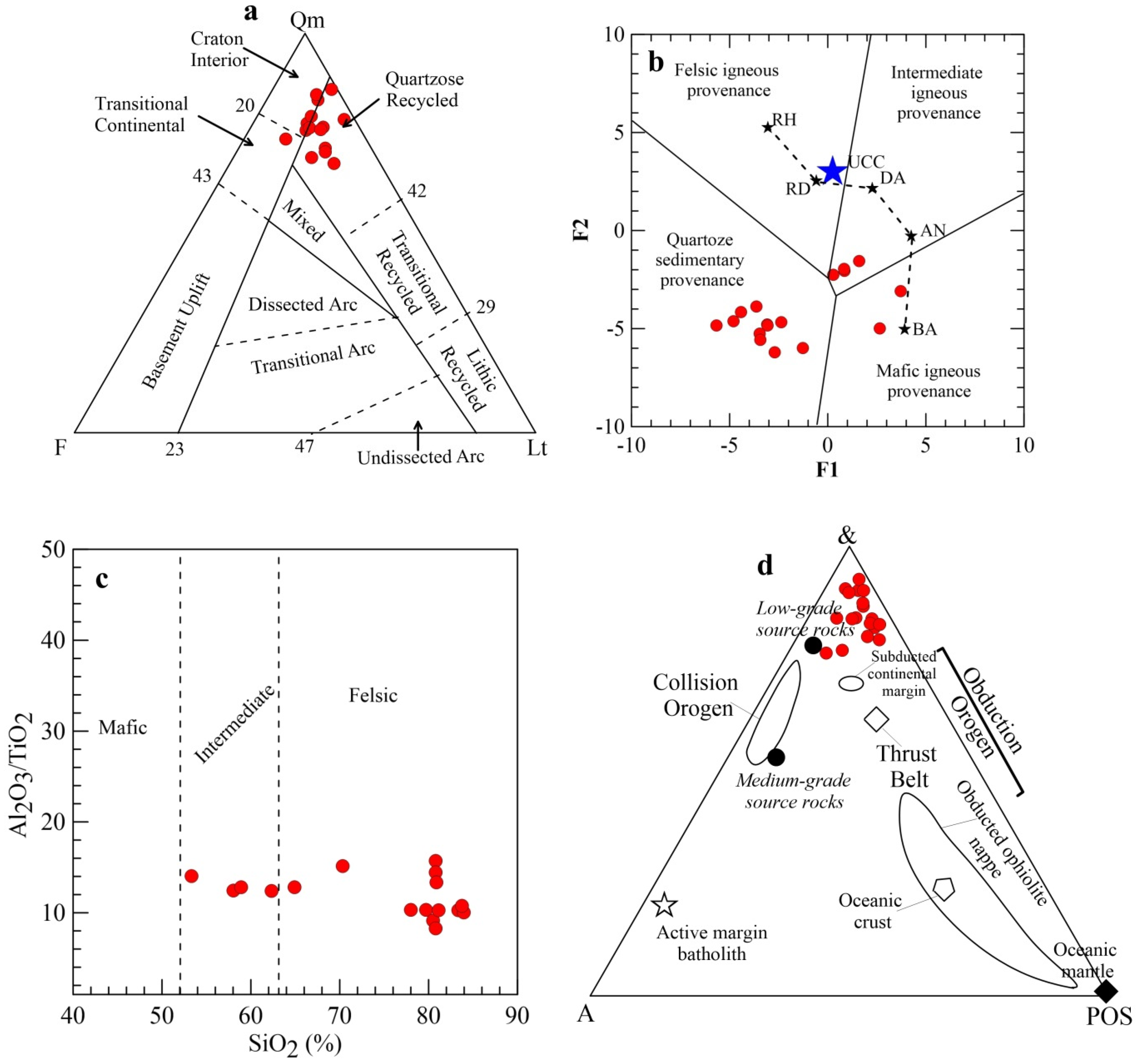
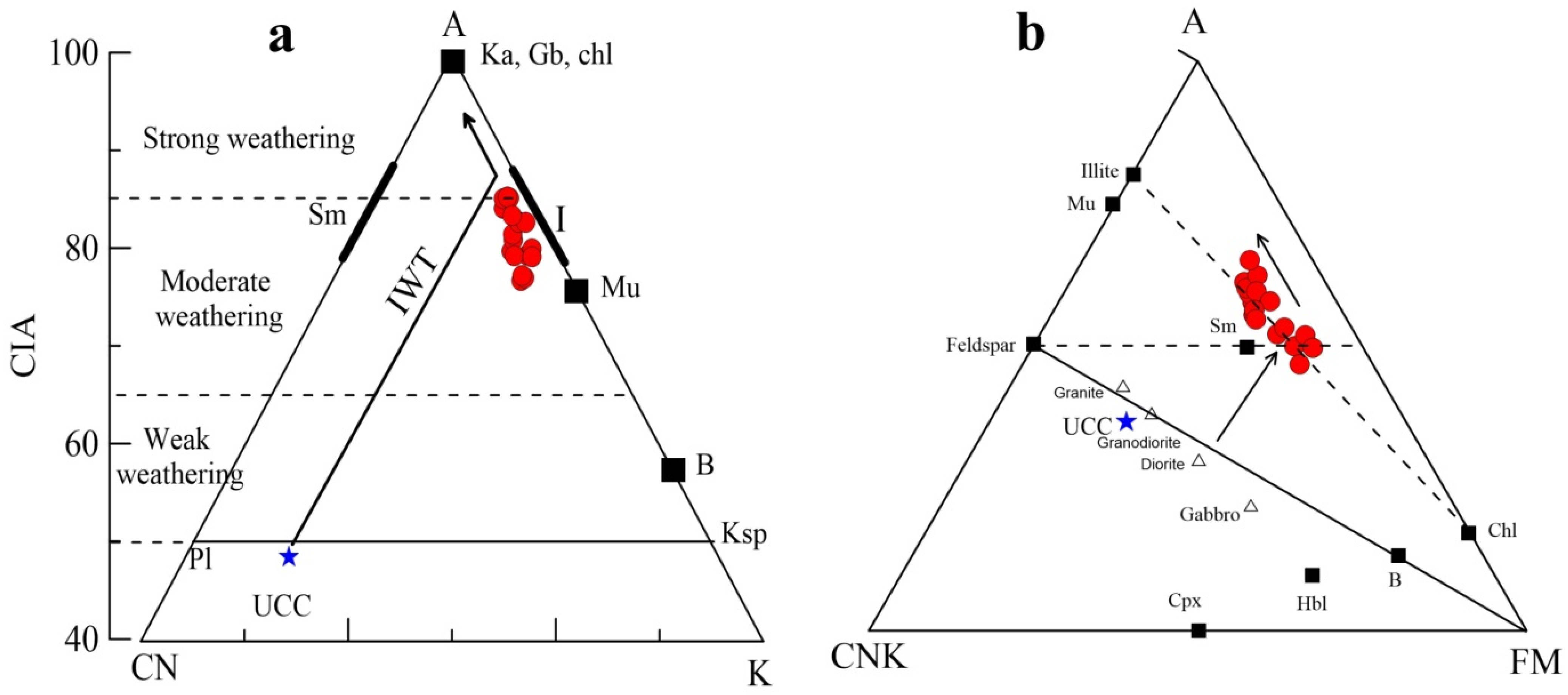
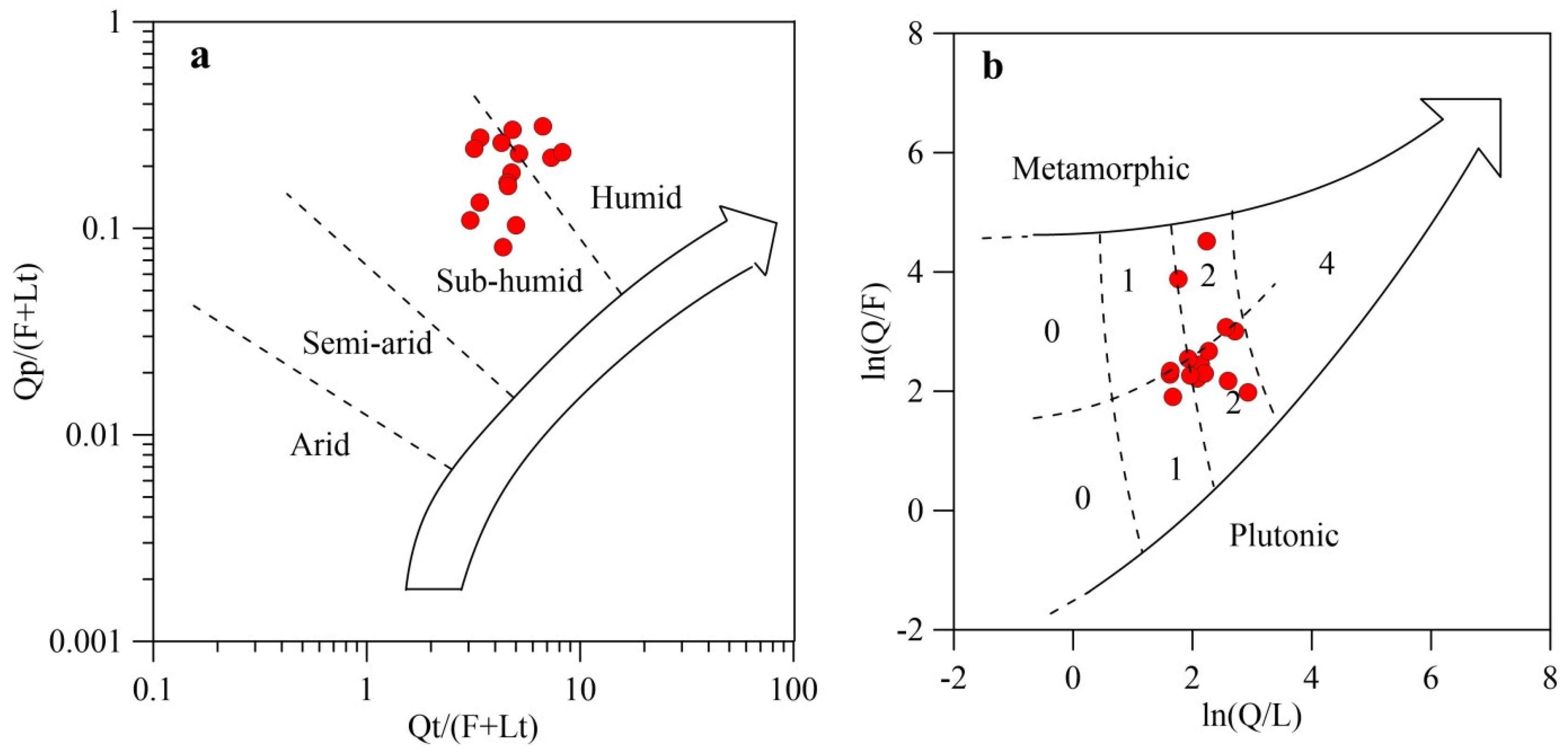
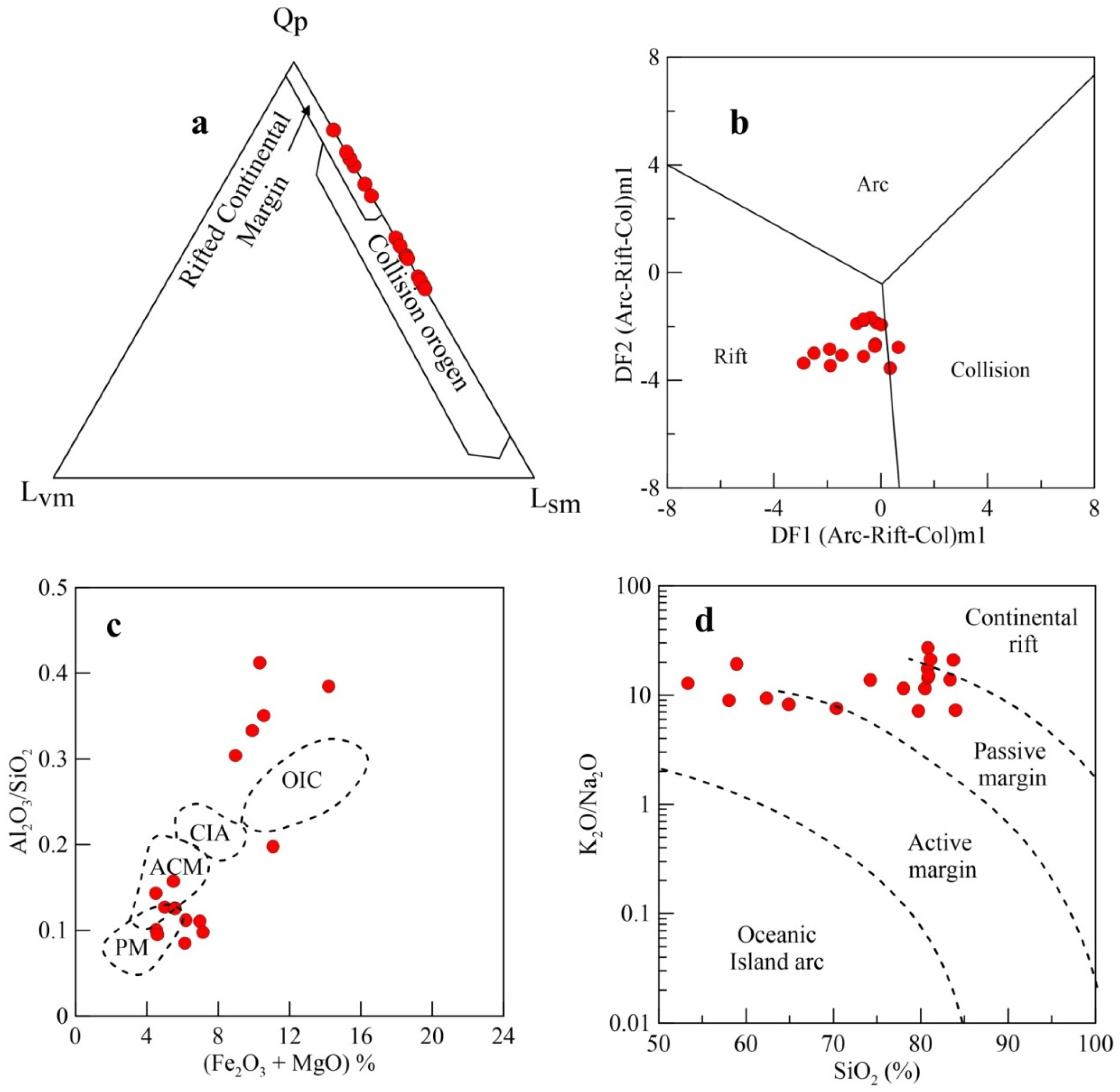
 |
| Sample No | BS03 | BS04 | BS06 | BS07 | BS10 | BS11 | BS12 | BS13 | BS14 | BS15 | BS19 | BS20 | BS22 | BS23 | BS24 | BS28 | BS29 | BS30 | Average | |
|---|---|---|---|---|---|---|---|---|---|---|---|---|---|---|---|---|---|---|---|---|
| Framework minerals (%) | ||||||||||||||||||||
| Quartz | Qm | 54.34 | 63.99 | 49.01 | 63.13 | 61.13 | 58.43 | 67.06 | 57.73 | 67.10 | 66.36 | 56.03 | 56.30 | 55.99 | 59.09 | 50.33 | - | - | - | 59.07 |
| Qp | 2.68 | 1.50 | 3.27 | 1.71 | 5.09 | 3.01 | 4.17 | 5.30 | 2.68 | 2.52 | 2.84 | 3.03 | 6.51 | 3.74 | 5.90 | - | - | - | 3.60 | |
| Feldspar | K | 5.95 | 6.02 | 4.91 | 3.19 | 6.08 | 5.10 | 3.05 | 4.03 | 1.79 | 0.34 | 3.38 | 4.53 | 5.03 | 1.15 | 4.21 | - | - | - | 3.92 |
| P | 2.50 | 1.17 | 2.30 | 2.42 | 1.48 | 1.07 | 0.48 | 0.32 | 1.43 | 0.42 | 1.22 | 1.55 | 1.48 | 0.14 | 1.20 | - | - | - | 1.28 | |
| Mica | M | 1.19 | 1.84 | 3.89 | 1.24 | 0.49 | 0.56 | 1.12 | 0.00 | 0.81 | 0.17 | 0.80 | 1.00 | 0.38 | 0.43 | 0.00 | - | - | - | 0.93 |
| B | 1.50 | 0.83 | 2.60 | 0.41 | 0.49 | 0.44 | 0.00 | 0.00 | 0.31 | 0.00 | 0.44 | 0.09 | 0.77 | 0.50 | 0.72 | - | - | - | 0.61 | |
| Chert | 0.00 | 0.25 | 0.59 | 0.01 | 0.69 | 0.00 | 0.28 | 0.25 | 0.04 | 1.19 | 0.34 | 0.33 | 0.04 | 1.16 | 0.22 | - | - | - | 0.36 | |
| Chlorite | 1.45 | 0.00 | 1.90 | 0.00 | 1.14 | 0.00 | 0.00 | 0.21 | 0.00 | 0.08 | 0.00 | 0.09 | 0.00 | 0.00 | 0.00 | - | - | - | 0.33 | |
| Lithic Grain | Ls | 2.34 | 0.50 | 1.00 | 2.00 | 1.00 | 2.21 | 1.16 | 2.21 | 2.87 | 2.00 | 3.15 | 3.64 | 3.10 | 3.29 | 5.29 | - | - | - | 2.38 |
| Lm | 8.40 | 7.68 | 1.79 | 5.67 | 3.93 | 4.59 | 3.58 | 4.27 | 2.51 | 5.32 | 5.39 | 8.11 | 5.69 | 7.49 | 5.68 | - | - | - | 5.34 | |
| Lv | 0.00 | 0.00 | 0.00 | 0.00 | 0.00 | 0.00 | 0.00 | 0.00 | 0.00 | 0.00 | 0.00 | 0.00 | 0.00 | 0.00 | 0.00 | - | - | - | 0.00 | |
| Matrix | 1.50 | 1.50 | 1.27 | 3.28 | 1.36 | 1.34 | 2.21 | 0.57 | 1.35 | 1.07 | 1.41 | 2.20 | 2.94 | 1.84 | 1.70 | - | - | - | 1.70 | |
| Cement | 0.53 | 1.19 | 0.32 | 1.07 | 2.81 | 1.18 | 1.58 | 0.59 | 1.97 | 1.07 | 1.69 | 1.34 | 1.88 | 2.45 | 3.47 | - | - | - | 1.54 | |
| Porosity | 17.63 | 13.53 | 27.15 | 15.87 | 14.32 | 22.08 | 15.30 | 24.51 | 17.15 | 19.46 | 23.32 | 17.78 | 16.20 | 18.72 | 21.27 | 18.95 | ||||
| Q | Recalculated to 100% | 74.82 | 81.00 | 83.95 | 83.01 | 84.14 | 82.58 | 89.59 | 85.34 | 89.03 | 89.51 | 81.77 | 76.89 | 80.34 | 83.89 | 77.44 | - | - | - | 82.89 |
| F | 11.09 | 8.88 | 11.57 | 7.17 | 9.60 | 8.28 | 4.44 | 5.89 | 4.12 | 0.98 | 6.38 | 7.88 | 8.36 | 1.73 | 7.45 | - | - | - | 6.92 | |
| L | 14.08 | 10.12 | 4.47 | 9.82 | 6.26 | 9.14 | 5.96 | 8.78 | 6.86 | 9.51 | 11.85 | 15.23 | 11.30 | 14.39 | 15.12 | - | - | - | 10.19 | |
| Lt | 13.41 | 9.68 | 6.06 | 9.38 | 10.02 | 9.81 | 8.91 | 11.78 | 8.06 | 9.84 | 11.38 | 14.78 | 15.30 | 14.51 | 16.87 | - | - | - | 11.32 | |
| Qm/Qp | 20.29 | 42.59 | 14.97 | 36.90 | 12.01 | 19.40 | 16.07 | 10.89 | 25.04 | 26.30 | 19.70 | 18.58 | 8.60 | 15.82 | 8.53 | - | - | - | 16.42 | |
| F+Lt | 21.86 | 16.86 | 13.27 | 14.98 | 17.57 | 15.97 | 12.45 | 16.13 | 11.28 | 10.60 | 15.97 | 20.87 | 21.80 | 15.80 | 22.28 | - | - | - | 16.51 | |
| Heavy Minerals (%) | ||||||||||||||||||||
| Zircon | 24.34 | 30.69 | 21.03 | 20.33 | 44.81 | 31.44 | 11.95 | 26.64 | 18.50 | 22.93 | 13.10 | 19.37 | 19.85 | 17.78 | 17.92 | 13.02 | 12.81 | 18.25 | 21.37 | |
| Tourmaline | 10.32 | 3.00 | 13.21 | 12.09 | 10.08 | 6.91 | 19.47 | 13.27 | 12.00 | 7.32 | 17.50 | 11.16 | 12.96 | 6.44 | 13.96 | 19.55 | 28.08 | 18.25 | 13.09 | |
| Rutile | 8.42 | 9.32 | 10.55 | 9.41 | 8.72 | 11.48 | 10.46 | 14.07 | 16.00 | 5.85 | 7.50 | 16.05 | 10.99 | 12.78 | 9.95 | 10.00 | 10.84 | 12.06 | 10.80 | |
| Garnet | 7.30 | 5.86 | 5.52 | 3.67 | 10.38 | 2.00 | 10.49 | 3.56 | 3.67 | 5.00 | 2.50 | 8.37 | 1.99 | 0.00 | 9.94 | 10.52 | 10.87 | 15.21 | 6.49 | |
| Kyanite | 0.50 | 0.00 | 1.29 | 0.00 | 0.00 | 0.00 | 0.00 | 0.00 | 0.00 | 0.98 | 0.00 | 1.90 | 0.00 | 0.00 | 0.00 | 0.80 | 0.49 | 0.00 | 0.33 | |
| Epidote | 2.33 | 2.50 | 1.89 | 0.00 | 5.57 | 2.61 | 2.38 | 1.01 | 2.50 | 5.37 | 3.50 | 2.37 | 3.96 | 3.00 | 8.91 | 1.10 | 1.32 | 1.13 | 2.86 | |
| Staurolite | 1.34 | 0.00 | 0.52 | 0.00 | 0.00 | 0.00 | 0.00 | 4.67 | 1.00 | 1.46 | 2.50 | 2.79 | 1.49 | 0.00 | 0.50 | 0.50 | 0.99 | 0.00 | 0.99 | |
| Hornblende | 2.24 | 2.50 | 2.73 | 2.64 | 3.30 | 4.45 | 3.90 | 2.27 | 3.50 | 9.76 | 1.00 | 3.12 | 2.36 | 6.11 | 1.88 | 1.07 | 4.93 | 8.76 | 3.70 | |
| Sillimanite | 0.79 | 0.60 | 0.00 | 0.00 | 0.00 | 0.96 | 1.00 | 2.40 | 0.00 | 0.00 | 3.00 | 1.80 | 1.48 | 0.00 | 0.50 | 0.00 | 0.00 | 0.52 | 0.72 | |
| Pyroxene | 7.42 | 8.39 | 7.58 | 9.33 | 7.72 | 9.23 | 5.40 | 4.77 | 2.50 | 4.39 | 3.00 | 3.02 | 5.62 | 3.22 | 9.70 | 3.75 | 5.62 | 6.91 | 5.98 | |
| Apatite | 0.00 | 3.50 | 1.55 | 1.33 | 0.94 | 0.48 | 2.99 | 3.27 | 4.00 | 1.46 | 5.50 | 1.86 | 1.43 | 0.56 | 0.00 | 0.00 | 0.00 | 2.58 | 1.75 | |
| Chloritoid | 1.89 | 0.66 | 0.72 | 0.67 | 0.00 | 0.00 | 0.50 | 3.74 | 1.11 | 0.98 | 1.50 | 0.93 | 3.45 | 6.67 | 2.97 | 0.72 | 0.13 | 0.00 | 1.48 | |
| Opaque | 30.26 | 32.98 | 32.67 | 38.67 | 7.08 | 28.61 | 29.99 | 17.90 | 31.80 | 32.85 | 37.50 | 25.49 | 31.97 | 41.67 | 22.38 | 38.98 | 22.46 | 16.34 | 28.87 | |
| Others | 2.86 | 0.00 | 0.76 | 1.86 | 1.42 | 1.83 | 1.48 | 2.42 | 3.42 | 1.66 | 1.90 | 1.77 | 2.46 | 1.78 | 1.40 | 0.00 | 1.48 | 0.00 | 1.58 | |
| ZTR Index | 61.77 | 64.17 | 66.52 | 68.21 | 68.45 | 69.80 | 59.81 | 65.76 | 68.18 | 53.76 | 60.96 | 62.51 | 64.37 | 63.43 | 53.89 | 69.75 | 66.71 | 58.04 | 63.67 | |
| POS | 7.42 | 8.39 | 7.58 | 9.33 | 7.72 | 9.23 | 5.40 | 4.77 | 2.50 | 4.39 | 3.00 | 3.02 | 5.62 | 3.22 | 9.70 | 3.75 | 5.62 | 6.91 | 5.98 | |
| A | 2.24 | 2.50 | 2.73 | 2.64 | 3.30 | 4.45 | 3.90 | 2.27 | 3.50 | 9.76 | 1.00 | 3.12 | 2.36 | 6.11 | 1.88 | 1.07 | 4.93 | 8.76 | 3.70 | |
| G+HgM | 9.93 | 6.46 | 7.32 | 3.67 | 10.38 | 2.96 | 11.49 | 10.63 | 4.67 | 7.44 | 8.00 | 14.86 | 4.96 | 0.00 | 10.93 | 11.82 | 12.35 | 15.73 | 8.53 | |
| & | 50.16 | 49.67 | 49.70 | 45.69 | 71.53 | 54.75 | 49.22 | 64.42 | 57.53 | 45.56 | 50.50 | 53.51 | 55.10 | 49.00 | 55.11 | 44.38 | 54.65 | 52.27 | 52.93 | |
| Sample No. | BS03 | BS04 | 21BS06 | BS07 | BS10 | BS11 | BS12 | BS13 | BS14 | BS15 | BS19 | BS20 | BS22 | BS23 | BS24 | BS28 | BS29 | Average |
|---|---|---|---|---|---|---|---|---|---|---|---|---|---|---|---|---|---|---|
| SiO2 | 64.89 | 78.02 | 58.05 | 80.89 | 83.97 | 58.91 | 81.12 | 83.75 | 80.8 | 80.79 | 53.33 | 80.8 | 70.33 | 80.48 | 62.33 | 79.72 | 83.35 | 74.21 |
| TiO2 | 1.54 | 1.19 | 1.92 | 0.67 | 0.79 | 1.61 | 0.77 | 0.66 | 1.09 | 0.73 | 1.46 | 0.71 | 0.92 | 1.1 | 1.68 | 0.97 | 0.81 | 1.10 |
| Al2O3 | 19.73 | 12.27 | 23.92 | 8.93 | 7.96 | 20.64 | 7.94 | 7.13 | 9.01 | 11.53 | 20.52 | 10.24 | 13.91 | 10.07 | 20.77 | 10.03 | 8.36 | 13.12 |
| Fe2O3 | 7.8 | 5.21 | 8.77 | 6.78 | 3.92 | 9.13 | 6.61 | 5.97 | 5.79 | 4.24 | 12.53 | 4.63 | 10.74 | 5.3 | 8.68 | 4.89 | 4.17 | 6.77 |
| MnO | 0.05 | 0.04 | 0.04 | 0.03 | 0.03 | 0.04 | 0.06 | 0.04 | 0.13 | 0.02 | 0.05 | 0.04 | 0 | 0.03 | 0.04 | 0.04 | 0.03 | 0.04 |
| MgO | 1.17 | 0.28 | 1.57 | 0.19 | 0.68 | 1.42 | 0.53 | 0.15 | 0.4 | 0.26 | 1.66 | 0.38 | 0.32 | 0.28 | 1.23 | 0.68 | 0.35 | 0.68 |
| CaO | 0.09 | 0.05 | 0.13 | 0.06 | 0.03 | 0.19 | 0.05 | 0.06 | 0.09 | 0.04 | 0.19 | 0.16 | 0.13 | 0.05 | 0.07 | 0.05 | 0.09 | 0.09 |
| Na2O | 0.44 | 0.15 | 0.47 | 0.08 | 0.24 | 0.22 | 0.08 | 0.05 | 0.11 | 0.09 | 0.32 | 0.06 | 0 | 0.13 | 0.42 | 0.3 | 0.13 | 0.19 |
| P2O5 | 0.15 | 0.07 | 0.12 | 0.05 | 0.05 | 0.09 | 0.13 | 0.03 | 0.08 | 0.05 | 0.1 | 0.06 | 0.1 | 0.9 | 0.18 | 0.04 | 0.03 | 0.13 |
| K2O | 3.59 | 1.72 | 4.19 | 1.19 | 1.74 | 4.18 | 1.75 | 0.99 | 1.53 | 1.57 | 4.16 | 1.71 | 2.43 | 1.56 | 3.92 | 2.15 | 1.75 | 2.36 |
| ZrO | 0.08 | 0.09 | 0.09 | 0.06 | 0.06 | 0.05 | 0.06 | 0.05 | 0.18 | 0.04 | 0.04 | 0.04 | 0.08 | 0.05 | 0.07 | 0.07 | 0.06 | 0.07 |
| CIA | 81.69 | 85.89 | 81.97 | 86.41 | 74.91 | 80.49 | 78.57 | 85.7 | 83.33 | 86.49 | 79.97 | 83.02 | 84.13 | 83.87 | 81.81 | 78.07 | 79.22 | 82.09 |
| PIA | 96.72 | 98.55 | 96.37 | 98.48 | 94.76 | 97.13 | 99.57 | 98.12 | 98.08 | 98.99 | 96.2 | 100 | 99.02 | 97.13 | 97.77 | 94.05 | 95.61 | 97.44 |
| CIW | 97.35 | 98.77 | 97.04 | 98.7 | 95.95 | 97.75 | 100 | 98.4 | 98.43 | 99.14 | 97.01 | 97.71 | 100.01 | 97.6 | 98.22 | 95.37 | 96.57 | 97.88 |
| SiO2/Al2O3 | 3.29 | 6.36 | 2.43 | 9.06 | 10.55 | 2.85 | 10.22 | 11.75 | 8.97 | 7.01 | 2.60 | 7.89 | 5.06 | 7.99 | 3.00 | 7.95 | 9.97 | 6.88 |
| Al2O3/TiO2 | 12.81 | 10.31 | 12.46 | 13.33 | 10.08 | 12.82 | 10.31 | 10.80 | 8.27 | 15.79 | 14.05 | 14.42 | 15.12 | 9.15 | 12.36 | 10.34 | 10.32 | 11.93 |
| TiO2/Zr | 18.25 | 12.91 | 21.22 | 11.57 | 12.82 | 29.49 | 12.81 | 12.11 | 5.91 | 16.94 | 39.67 | 19.78 | 11.75 | 20.26 | 23.11 | 14.16 | 14.06 | 17.46 |
| K2O/Al2O3 | 0.18 | 0.14 | 0.18 | 0.13 | 0.22 | 0.20 | 0.22 | 0.14 | 0.17 | 0.14 | 0.20 | 0.17 | 0.17 | 0.15 | 0.19 | 0.21 | 0.21 | 0.18 |
| K2O/Na2O | 8.16 | 11.47 | 8.91 | 14.88 | 7.25 | 19.00 | 21.88 | 19.80 | 13.91 | 17.44 | 13.00 | 28.50 | - | 12.00 | 9.33 | 7.17 | 13.46 | 14.13 |
| Na2O + K2O | 4.03 | 1.87 | 4.66 | 1.27 | 1.98 | 4.40 | 1.83 | 1.04 | 1.64 | 1.66 | 4.48 | 1.77 | 2.43 | 1.69 | 4.34 | 2.45 | 1.88 | 2.55 |
| Log(SiO2/Al2O3) | 0.52 | 0.80 | 0.39 | 0.96 | 1.02 | 0.46 | 1.01 | 1.07 | 0.95 | 0.85 | 0.41 | 0.90 | 0.70 | 0.90 | 0.48 | 0.90 | 1.00 | 0.78 |
| Log(Fe2O3/K2O) | 0.34 | 0.48 | 0.32 | 0.76 | 0.35 | 0.34 | 0.58 | 0.78 | 0.58 | 0.43 | 0.48 | 0.43 | 0.65 | 0.53 | 0.35 | 0.36 | 0.38 | 0.48 |
| Log(Na2O/K2O) | −0.91 | −1.06 | −0.95 | −1.17 | −0.86 | −1.28 | −1.34 | −1.30 | −1.14 | −1.24 | −1.11 | −1.45 | - | −1.08 | −0.97 | −0.86 | −1.13 | −1.12 |
Disclaimer/Publisher’s Note: The statements, opinions and data contained in all publications are solely those of the individual author(s) and contributor(s) and not of MDPI and/or the editor(s). MDPI and/or the editor(s) disclaim responsibility for any injury to people or property resulting from any ideas, methods, instructions or products referred to in the content. |
© 2024 by the authors. Licensee MDPI, Basel, Switzerland. This article is an open access article distributed under the terms and conditions of the Creative Commons Attribution (CC BY) license (https://creativecommons.org/licenses/by/4.0/).
Share and Cite
Mohinta, S.; Sayem, A.S.M.; Rahman, M.J.J.; Alam, M.S.; Abdullah, R. Mineralogy and Major Element Geochemistry of the Oligocene Barail Group Sandstones from the Sylhet Trough, Bengal Basin: Provenance and Tectonic Implications. Minerals 2024, 14, 985. https://doi.org/10.3390/min14100985
Mohinta S, Sayem ASM, Rahman MJJ, Alam MS, Abdullah R. Mineralogy and Major Element Geochemistry of the Oligocene Barail Group Sandstones from the Sylhet Trough, Bengal Basin: Provenance and Tectonic Implications. Minerals. 2024; 14(10):985. https://doi.org/10.3390/min14100985
Chicago/Turabian StyleMohinta, Sunjuckta, Abu Sadat Md Sayem, M. Julleh Jalalur Rahman, Md Sha Alam, and Rashed Abdullah. 2024. "Mineralogy and Major Element Geochemistry of the Oligocene Barail Group Sandstones from the Sylhet Trough, Bengal Basin: Provenance and Tectonic Implications" Minerals 14, no. 10: 985. https://doi.org/10.3390/min14100985
APA StyleMohinta, S., Sayem, A. S. M., Rahman, M. J. J., Alam, M. S., & Abdullah, R. (2024). Mineralogy and Major Element Geochemistry of the Oligocene Barail Group Sandstones from the Sylhet Trough, Bengal Basin: Provenance and Tectonic Implications. Minerals, 14(10), 985. https://doi.org/10.3390/min14100985








